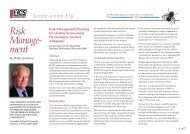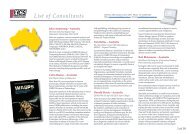Manual for Diagnosis of Screw-worm Fly - xcs consulting
Manual for Diagnosis of Screw-worm Fly - xcs consulting
Manual for Diagnosis of Screw-worm Fly - xcs consulting
You also want an ePaper? Increase the reach of your titles
YUMPU automatically turns print PDFs into web optimized ePapers that Google loves.
4- Myiasis: Differential <strong>Diagnosis</strong><br />
(Plates 2-6)<br />
Although the end results <strong>of</strong> unrestricted oviposition by SWF are spectacular, this cannot be<br />
said <strong>of</strong> more recently established myiases, which may be insidious and readily overlooked,<br />
even following close examination (see Fig. 33). This is particularly important in relation to<br />
quarantine and the detection <strong>of</strong> invasion into hitherto uninfested areas, and should be drawn<br />
to the attention <strong>of</strong> all people in Australia associated with livestock, including graziers, animal<br />
health <strong>of</strong>ficers and veterinarians. At the quarantine level, infestation by C. bezziana may not<br />
be evident initially in epizootic proportions, as the term ‘exotic disease’ might be taken to<br />
imply.<br />
The clinical syndrome, pathogenesis, pathology and differential diagnosis <strong>of</strong> C. bezziana<br />
infestations have been studied and described by Humphrey et al. (1980) and Spradbery and<br />
Humphrey (1988).<br />
Predisposing conditions<br />
Infestations are generally associated with traumatic injury, erosive or ulcerative lesions or<br />
haemorrhage. Differences in occurrence and site <strong>of</strong> myiasis between animal species probably<br />
reflect behavioural, environmental and husbandry factors rather than innate differences in<br />
susceptibility.<br />
Infestation commonly follows parturition. The navel <strong>of</strong> the new born and the vulval or<br />
perineal region <strong>of</strong> the dam, particularly when traumatised, are principal sites <strong>of</strong> infestation.<br />
Husbandry procedures such as dehorning, castration, branding, docking and ear tagging are<br />
also common sites <strong>of</strong> infestation. Myiasis associated with otitis externa has been seen in<br />
dogs, and myiasis associated with foot abscess has been seen in sheep and cattle. In<br />
Australia, the technique <strong>of</strong> ‘mulesing’ sheep would provide an ideal medium <strong>for</strong> screw-<strong>worm</strong><br />
fly myiasis. Traumatic injuries due to barbed wire or other penetrating objects are also<br />
commonly infested. Skin punctures caused by cattle tick and the lesions associated with<br />
buffalo fly infestations are attractive to screw-<strong>worm</strong> fly and provide ideal sites <strong>for</strong> myiasis<br />
in areas <strong>of</strong> Australia where the screw-<strong>worm</strong> fly would be expected to survive throughout the<br />
year. A particularly important feature <strong>of</strong> the disease in sheep, with major consequences <strong>for</strong><br />
the Australian sheep industry, is the ability <strong>of</strong> C. bezziana to invade the intact perineal region<br />
<strong>of</strong> ewes in the absence <strong>of</strong> overt trauma or haemorrhage (Plate 5).<br />
Course <strong>of</strong> myiasis<br />
Agriculture, Fisheries and Forestry - Australia<br />
Myiasis by C. bezziana begins with the early larval invasion <strong>of</strong> the disrupted epidermis,<br />
where the larvae aggregate in small cavities up to 5-10mm in diameter. There the larvae<br />
are bathed in small quantities <strong>of</strong> serous fluid and are visibly active. Within 24 hours, the<br />
cavities enlarge and extend laterally and deeply into the subcutaneous tissue and muscle. A<br />
sero-sanguinous exudate is evident at this stage. Progressive liquefactive necrosis <strong>of</strong> muscle<br />
and skin continues, associated with larval growth and invasion until a large cavernous lesion<br />
with irregular ragged edges is present. The depths <strong>of</strong> the lesion contain a seething, pulsating<br />
mass <strong>of</strong> larvae immersed in copious quantities <strong>of</strong> necrotic, fibrino-purulent or liquefied tissue<br />
and blood (see wound biopsy, Plate 4). Haemorrhage from the lesion may be severe and the<br />
15




